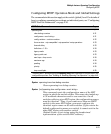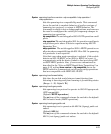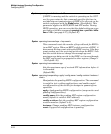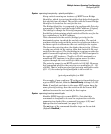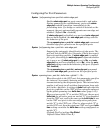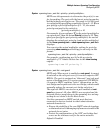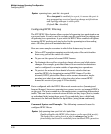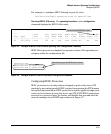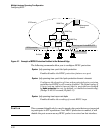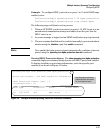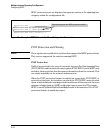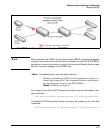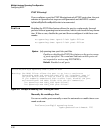
Multiple Instance Spanning-Tree Operation
Configuring MSTP
Syntax: spanning-tree < port-list > priority < priority-multiplier >
MSTP uses this parameter to determine the port(s) to use
for forwarding. The port with the lowest priority number
has the highest priority for use. The range is 0 to 240, and
is configured by specifying a multiplier from 0 - 15. When
you specify a priority multiplier of 0 - 15, the actual
priority assigned to the switch is:
(priority-multiplier) x 16
For example, if you configure “2” as the priority multiplier
on a given port, then the actual Priority setting is 32. Thus,
after you specify the port priority multiplier, the switch
displays the actual port priority (and not the multiplier)
in the show spanning-tree or show spanning-tree < port-list >
displays.
You can view the actual multiplier setting for ports by
executing show running and looking for an entry in this
format:
spanning-tree < port-list > priority < priority-multiplier >
For example, configuring port A2 with a priority
multiplier of “3” results in this line in the show running
output:
spanning-tree A2 priority 3
Syntax: spanning-tree < port-list > root-guard
MSTP only. When a port is enabled as root-guard, it cannot
be selected as the root port even if it receives superior STP
BPDUs. The port is assigned an “alternate” port role and
enters a blocking state if it receives superior STP BPDUs.
(A superior BPDU contains “better” information on the
root bridge and/or path cost to the root bridge, which would
normally replace the current root bridge selection.)
The superior BPDUs received on a port enabled as root-
guard are ignored. All other BPDUs are accepted and the
external devices may belong to the spanning tree as long
as they do not claim to be the Root device.
Use this command on MSTP switch ports that are
connected to devices located in other administrative
network domains to:
• Ensure the stability of the core MSTP network topology
so that undesired or damaging influences external to the
network do not enter.
• Protect the configuration of the CIST root bridge that
serves as the common root for the entire network.
Default: Disabled.
4-29



